Dynamic Adaptive Streaming over HTTP Dataset
Stefan Lederer, Christopher Müller, and Christian Timmerer
Alpen-Adria-Universit?t Klagenfurt
Universit?tsstra?e 65-67
9020 Klagenfurt am W?rthersee, Austria
+43 (0) 463 2700 3600
{firstname.lastname}@itec.uni-klu.ac.at
ABSTRACT
The delivery of audio-visual content over the Hypertext Transfer Protocol (HTTP) got lot of attention in recent years and with
dynamic adaptive streaming over HTTP (DASH) a standard is now available. Many papers cover this topic and present their
research results, but unfortunately all of them use their own private dataset which –– in most cases –– is not publicly available.
Hence, it is difficult to compare, e.g., adaptation algorithms in an objective way due to the lack of a common dataset which shall be
used as basis for such experiments. In this paper, we present our DASH dataset including our DASHEncoder, an open source
DASH content generation tool. We also provide basic evaluations of the different segment lengths, the influence of HTTP server
settings, and, in this context, we show some of the advantages as well as problems of shorter segment lengths.
我们提供开源的DASH内容生成工具: DASHEncoder和通用的数据集, 并做了基本的评测。
Categories and Subject Descriptors
D.5.1 [Multimedia Information System]: Video
General Terms
Algorithms, Measurement, Standardization, Documentation.
Keywords
Dynamic Adaptive Streaming over HTTP, DASH, Dataset, Encoder, Content Generation Tool
1. INTRODUCTION【介绍】
Online video portals like YouTube or Netflix deploy progressive download or adaptive video on demand systems and count
millions of users watching their content every day. Real-time entertainment produces already nearly 50% of the U.S. peak
traffic nowadays, with almost 30% of the total U.S. downstream traffic produced by Netflix [1]. Due to these enormous
infrastructure and bandwidth needs those costs became a huge problem for content service providers (CSP).
在线视频服务是互联网流量的第一大用户。
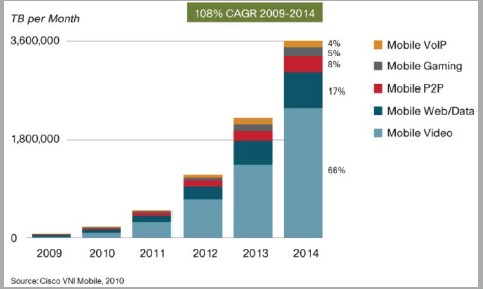
Figure 1: Mobile Data Volume Growth [5].
HTTP streaming and especially adaptive HTTP streaming got much attention in the past few years. Proprietary systems like
Microsofts?’ Smooth Streaming [2], Adobes?’ HTTP Dynamic Streaming [3] or Apples?’ HTTP Live Streaming [4] provide
similar approaches by leveraging existing content delivery network (CDN) and proxy cache infrastructures which costs are
significant lower than dedicated streaming server like the Flash Media Server or other competing products.
Adobe, MS, Apple都提供了自己的HTTP流技术方案。
But leveraging existing and cheap HTTP infrastructures is not the only reason for adaptive HTTP streaming. Due to the increasing
availability of mobile high speed Internet connections like WLAN/3G/4G and the huge smartphone boom in the recent years,
mobile video streaming is becoming more and more important. As shown in Figure 1, the annual growth of mobile video will be
more than 100% over the next years until a total share of up to 66% of the total mobile traffic in 2014. However, basic
progressive HTTP download/streaming is not suitable for these mobile environments with considerable high bandwidth
fluctuations. The video stream has to adapt to the varying bandwidth capabilities in order to deliver the user a continuous
video stream without stalls at the best possible quality for the moment, which is achieved by dynamic adaptive streaming over
HTTP [5][6].
3G/4G网络,移动用户是将来增长的重点。 但原有的流媒体技术对它们的支持度不好。
In this context, the emerging ISO/IEC MPEG standard Dynamic Adaptive Streaming over HTTP (DASH) [7] may get a lot of
attention in the upcoming years and probably will become an important as well as company-independent adaptive HTTP
streaming standard for all types of devices like PCs, Smartphones, Set-Top Boxes, etc. Hence, it is important to provide easy content
generation tools and test content for researchers and developers. Unfortunately, there is currently no common test content
dedicated to DASH available, showing the basic possibilities of the standard. In this paper we present our easy-to-use DASH
content generation tool called DASHEncoder, which enables the user to encode and multiplex DASH-compliant content in
segmented and continuous file structure with the associated Media Presentation Description (MPD). Furthermore, we provide a
DASH dataset comprising full-length sequences of various genres encoded at different representations in terms of bitrate,
resolution, and quality.
DASH技术是现在最受关注的解决方案。
我们提供了易用的DASH内容生成工具:DASHEncoder,
它能进行编码并进行流的混合生成MPD。
The remainder of this paper is organized as follows. Section 2 describes related work. The content generation is described in
Section 3 and Section 4 provides details about the actual dataset. In Section 5 we use the dataset to evaluate the influence of the
segment size and various Web server configurations to the streaming performance. The paper concludes with Section 6
including future work.
本文的章节内容划分。
2. Related Work【相关工作】
A detailed evaluation of the media formats of current adaptive streaming systems and a low overhead container format for
adaptive streaming is described in [8]. [9] analyzes the quality improvements when using adaptive HTTP streaming over
multiple heterogeneous network interfaces.
相关的评估分析。
Microsoft Smooth Streaming is presented in [10] with two test sequences of about 10 minutes of the open source movie Big
Buck Bunny. They offer the clip in different resolutions up to 720p and 1080p respectively, with 8 quality levels from about 230
kbit/s up to 3 Mbit/sec. The content generation for Microsoft Permission to make digital or hard copies of all or part of this work for
personal or classroom use is granted without fee provided that copies are not made or distributed for profit or commercial advantage and that
copies bear this notice and the full citation on the first page. To copy otherwise, or republish, to post on servers or to redistribute to lists,
requires prior specific permission and/or a fee.
MS提供的测试样本。
Smooth Streaming is done by the IIS Transform Manager, which performs a fully automated transcoding of content to Microsoft
Smooth Streaming compatible fragmented MP4 files at different quality levels.
Adobe offers test videos for their Dynamic HTTP Streaming together with the standard installation of their Flash Media Server
[11]. This includes sample encodings of approx. 2 minutes ranging from 150 kbit/s to 1500 kbit/s which comes together with
the Flash Media Server. For content generation they also offer a command line based packaging tool called File Packager which
performs the segmentation and packaging of the raw video/audio streams. The encoding of the videos has to be done separately,
e.g., using the Adobe Encoder or x264 as an open source alternative [3].
Adobe提供的DASH测试样本。
Currently, the only available DASH content is the adapted 3GPP Adaptive HTTP Streaming (AHS) test content of Ericsson Labs
which is available in[12]. They offer two clips, Mountain Bike (HVGA resolution) and Snowboard (VGA resolution) with a
length of approx. 4 and 5 minutes respectively. This test content is offered at different bitrates ranging from 200 kbit/s to 1200 kbit/s
but it maintains the same resolution. However, this content uses segments with a length of 10 seconds which is a restriction when
testing, e.g., high bandwidth fluctuations or adaption algorithms like in [9].
目前,只有DASH方案被3GPP采纳。
Finally, MP4Box from GPAC [13] supports the generation of fragmented MP4 files and basic MPDs for separate
representations. At the time of writing of this paper, MP4Box supports only one representation which is also used as the basis
for our DASHEncoder introduced in the next section.
MP4Box提供了MP4分段和生成MPD的功能。
3. Content Generation【内容生成】
For this dataset we developed a new content generation tool ?– on top of GPAC?’s MP4Box – for DASH video on demand content
called DASHEncoder. Using our DASHEncoder the user does not need to encode and multiplex each quality level of the final
DASH content separately. The DASHEncoder steps are depicted in Figure 2. It generates the desired representations (quality/bitrate
levels), fragmented MP4 files, and MPD file based on a given configuration file (e.g., as shown in Figure 3) or by command line
parameters respectively.
基于MP4Box的DASHEncoder提供了生成多级别多码率流,切分MP4文件,
封装MPD的功能,如图2所示。

Figure 2: DASHEncoder Content Generation Steps.
Given the set of parameters the user has a wide range of possibilities for the content generation, including the variation of
the segment size, bitrate, resolution, encoding settings, URL, etc., which is shown by the example of a DASHEncoder configuration
file in Figure 3. Due to this easy batch processing of multiple encodings to one final DASH source it is also possible to use this
application fully automatically, e.g., on user-driven social video platforms like YouTube, without any time consuming manual
work of system administrators.
# x264 Options
#=========================
bitrate : 200|400|600|1000
statistics : stat.temp
gop : 48
profile : baseline
preset : slow
input : /home/stefan/foreman_cif.y4m
passes : 1
const-filesize : 0
# MP4Box Options
#=========================
fragment-size : 2000
segment-size : 2000
rap-aligned
segment-name : foreman
folder-prefix : foreman
# MPD Options
#=========================
mpd-name : foreman.mpd
url-root : http://localhost/foreman_stats/
set-base-url
Figure 3: DASHEncoder Configuration File Example.
图3是DASHEncoder的配置文件示例,它对
分段文件大小,比特率,图像尺寸,编码参数,URL等都做了设置。
The DASHEncoder is available open source at [14] with the aim that other developers will join this project. The content generated
with the DASHEncoder is compatible with [15] which can be used as a decoder and player respectively.
DASHEncoder现已开源,并有配套的解码器。
We developed the DASHEncoder in a very generic way which allows us to add new encoding and multiplexing tools with very
low effort and with the usage of the existing parameters and configuration files respectively. Even other video codecs and/or
container formats can be integrated in the same way. For example, in addition to the currently integrated AVC/MP4 tools presented
in this paper, it is also possible to generate fragmented WebM files which use the VP8 video encoder and a subset of the
Matroska container format. Furthermore, it shall be also possible to integrate, e.g., the Adobe packaging tool for HTTP Dynamic
Streaming in DASHEncoder and use the same encoded AVC files for the generation of Adobe HTTP Dynamic Streaming compliant
content.
DASHEncoder是可以添加各种新的编码器。
For the current dataset we used our DASHEncoder with x264 [16] for the video encoding and MP4Box [13] for the multiplexing as
well as for the MPD generation on representation level. Based on these separate MPDs our software generates a combined MPD file
containing all representations. This MPD file fits to the generated file structure of the DASHEncoder and the provided URL of the
configuration file so that one has no need to edit this file after the content generation process.
现在的DASHEncoder使用了X264进行编码,用MP4Box进行MPD封装。

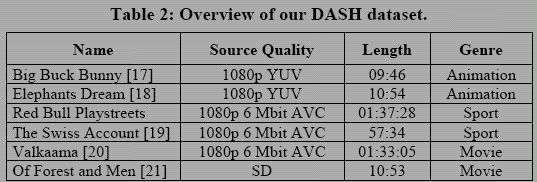
In order to retrieve the best suitable bitrate vs. resolution configuration we analysed the PSNR values of the encoded
content of several overlapping bitrate configurations. For this we decoded the encoded videos with ffmpeg and upscaled the lower
resolution encodings with a bilinear scaling filter to the resolution of the source video. Based on this we calculated the PSNR value
of each encoding compared to the original source video. Using this metric we retrieved the best bitrates to change the resolution
of the encoded content to provide a continuous quality increase through low to high bitrate levels.
我们的评价标准是和ffmpeg生成的样本做PSNR对比。
For the subsequent multiplexing and segmentation step it is necessary to maintain fixed I-frame positions of the video which
is achieved by restricting the GOP-size of the encoder to the desired segment size of the content. As a consequence, smaller
segment sizes have a disadvantage because of their high number of I frames which need more bits in the overall bitstream.
Furthermore, smaller GOP sizes also provide a lower encoding performance and quality which is also shown in [1]. Table 1
shows the PSNR values for different segment sizes and provides evidence that this needs to be considered in the evaluation process
for the segment sizes of DASH streaming systems.
对于子序列的混合和切分来说,
通过在编码端以期望的内容片段大小来设置GOP尺寸,
以获得相同的I帧位置的视频流是必须的。
但是,小的分段有一定的弊端:因为I帧会占用大量的编码比特,从而导致整体的
分段图像质量下降。
The time needed for the content generation of one representation in 1080p resolution based on a YUV source video and using 2
Xeon 2,33 GHz CPUs corresponds to the video playback time on average, however lower resolution representations can be
generated significantly faster. In this process the time needed is mainly dependent on the x264 encoder and the settings used
therefore, the multiplexing and MPD generation in contrast is done in less than 5 % of the total time.
1080P样本的生成时间,在我们的CPU上,和它的播放时长是一样的。
当然,小尺寸的样本生成时间会快些。
而生成MPD的时间小于总生成时间的5%。
4. DASH Dataset【DASH数据集】
4.1 Introduction【介绍】
During our research on adaptive video streaming and DASH we always had the problem that there is no DASH test content
available to perform objective comparisons of streaming algorithms and systems. In general there is hardly any DASH
content available at all, except the two test sequences from [12].
DASH的测试素材太少了。
Some papers used common test sequences like Foreman et al. for their video streaming tests, which are in general quite short for
those kind of experiments, in the case of Foreman the length is 300 frames. One approach is to concatenate the same sequence
over and over again in order to have a longer sequence for the evaluation. This approach has the disadvantage that the video
characteristics are quite the same over the whole experiment which is often not the case in the real-world. In such cases one
usually faces a tradeoff between high and low motion scene, fadein and fade-out, and also quality changes. It is also not always
possible to achieve a continuous constant bitrate of an encoded video, especially at higher bitrates due to, e.g., low motion scenes.
Therefore, full-length sequences are needed in order to provide more realistic results.
而用常用的foreman样本做测试,它的序列帧数也太少了。
Our DASH dataset comprises the sequences as shown in Table 2 and located at [22]. All animation and movie sequences are
licensed under Creative Commons-BY 2.0, so they are free to share and modify. Both sport sequences are free to use for
research purposes.
我们用的素材见表2.
4.2 Representations, Segment Lengths and MPDs
【表示,分段长度和MPD】
Table 3 shows the representation levels of our dataset. We decided to distinguish the quality level configuration between
types of video and to offer at least two sequences with the same configuration. This is useful because of the different scene
characteristics (high motion in sport, low detail in Animation, etc.) of the chosen video types. It is also important to mention that
the sport and movie genres have only a maximum quality of 6 Mbit/sec. due to fact that our source video files are encoded at 6
Mbit/sec. Another limitation arises at the animation videos due to the lack of achieving the target bitrate of the x264 encoder at
higher bitrates for this type of content. Therefore, the higher bitrate encodings are finally encoded at a lower bitrate than
desired (the MPDs entries represent the bitrate of the encoded videos).
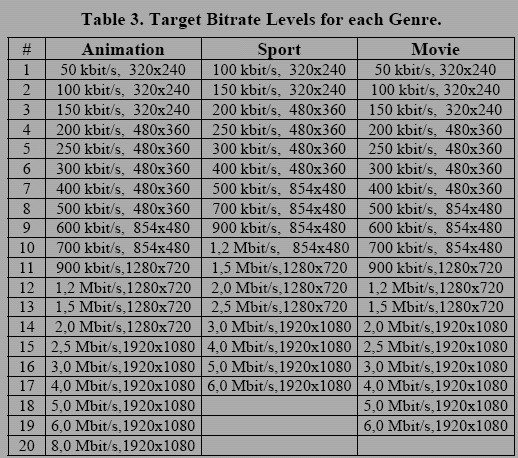
表3是我们使用的数据集和表示的分级。
但是实际上,当码率达到8Mbits/s时,x264的能力也在限,实际上是没有这么高的。
Additionally, the DASH dataset is encoded and multiplexed using different segment sizes inspired by commercial products ranging
from 2 seconds (i.e., Microsoft Smooth Streaming [2]) to 10 seconds per fragment (i.e., Apple HTTP Streaming [4]) with some
steps in between and at the lower end. Thus, we end up with the segments sizes of 1, 2, 4, 6, 10 and 15 seconds. The length of the
segments is a very important decision when providing content for adaptive streaming. Shorter segments may provide a larger
overhead in term of requests, which is shown in the evaluation section, and result in more quality switches, with the cost of a
lower encoding efficiency. On the other hand, longer segments are not very handy in environments with high bandwidth fluctuations
like mobile networks, because the client cannot adjust the video stream as fast as it would be needed in case of a significant
bandwidth drop.
我们使用的DASH数据集还设置了不同的分段长度:
1,2, 4, 6, 10,15秒。
分段的长度在自适应流中很重要。
分段越短,则会产生更多的分段请求,从而导致更多的切换。
分段越长,同样也会有弊端:
它会导致在移动网络中,当客户端的网络状况已显著下降时,
不能尽可能快做流切换。
In this dataset we offer any content in a version with separate segments and the corresponding MPD. Additionally, we also offer
an unsegmented version of the videos and the corresponding MPD for the movies of the animation genre, which allows for byterange
requests. The provided MPDs of the dataset are based on the 2nd Draft International Standard (DIS) of DASH [7] and are
also available in the version compatible with the current implementation of the DASH VLC Plugin [15].
在数据集中还提供的未分段的样本。
4.3 PSNR Statistics【PSNP统计】
The average bitrate of the streamed video is a good metric for DASH clients and their stream switching algorithms. But the
bitrates do not necessarily correspond to the quality of the video, especially because of the differences in encoding efficiency
between high- and low-motion scenes. Usually the encoder compensates those differences by adjusting the bitrate over the
whole video to get the best overall quality. However, due to the constant bitrate of DASH representations, which is more or less
constant all over the video (or at least the current DASH-Period), this is not possible in our scenario. Thus, it can be useful to
consider the PSNR as a metric for stream switching algorithms in certain cases.
现有版本的DASH规定了码流要使用固定码率,因为不能做全局的扫描和
码率分配,所以图像质量会有一些下降。
Therefore, we also provide PSNR values on frame level of the Big Buck Bunny encodings. Those values are available for each frame
of each representation and each segment length version of this video, which sums up in more than 1.7 million PSNR values. One
can find them together with the dataset in comma separated value (CSV) as well as Microsoft Excel files [22]. As an example,
Figure 4 shows the PSNR values of 4 representations of about 850 frames of the 2-second segment length version of our Big Buck
Bunny encoding.
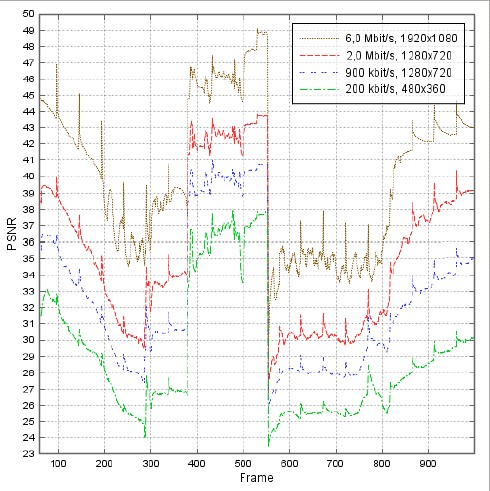
Figure 4: PSNR Value Example of different Representations.
图4是PSNR对比图。
4.4 Dataset Usage【数据集使用】
Our dataset can be used for many kinds of evaluations in the context of MPEG-DASH like e.g. the comparison of different
stream switching algorithms, the caching performance of CDNs and proxies, new applications on top of DASH, etc. The main
advantage of our dataset is that it now enables the objective comparison of research results across different institutions
working in this field. The dataset and a short compendium of its characteristics can be found in [22] where it is possible either to
stream the video directly from our Web server or download the files via FTP.
我们做的数据集可用于各种评测,可以去我们的FTP上下载。
5. Evaluation【评测】
5.1 Introduction【介绍】
Together with the dataset we provide some basic evaluations of the streaming characteristics of the different segment length
versions of the videos and their impact on the average bitrate of the streamed video. Therefore, we evaluate the streaming
performance of each segment length version in terms of average bitrate and interpolate a graph to find the optimal segment length
for the given network scenario.
我们对整个系统做了基本的评测。
During our first tests we realized different Web server configurations on our hosting provider?’s sites. Some of them
allow persistent connections, as defined in HTTP 1.1 [23], and some restrict the reuse of connections for multiple requests by
closing the connection after the response. This is signaled by the Connection: close field of the HTTP 1.1 response header. Other
providers limit the Keep-Alive-Time to 1 second, which is quite short in comparison to the 15 second standard configuration of the
Apache Web server [24]. Due to this difference in todays?’ available Web server configurations we also decided to analyze
the impact thereof w.r.t. the streaming performance and segment lengths.
Web服务器使用的是HTTP 1.1, 和一些基本设置。
5.2 Evaluation Setup【评测设置】-
As a first step, we built a test environment (shown in Figure 5 and similar to [25]) emulating standard Internet connections to show
the impact of the HTTP server configuration on DASH. Therefore, we used a standard Apache Web server as source of our
DASH streaming scenario which has a wide range of configuration possibilities regarding connections. The DASH
client is a modified version of the DASH VLC plugin [15], with some minor changes regarding logging. Additionally, we used two
Ubuntu nodes which act as gateways to emulate the typical network characteristics of a last mile Internet connection (e.g.
ADSL). One node ?– network emulation ?– emulates the Internet service provider characteristics by adding a delay of 150 ms using
NetEm (packet loss/packet reordering are currently not considered to keep this example evaluation simple). The other node ?– traffic
shaping ?– simulates scenarios of fluctuating bandwidth conditions.
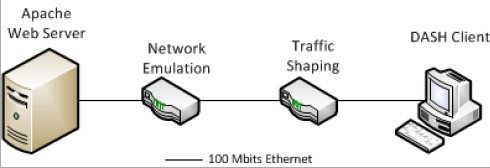
Figure 5: Network Emulation Environment.
我们的测试环境为:
Apache Web Server和DASH VLC插件,并建立了两个网络仿真结点,
以用于模拟网络负载情况。
5.3 System Parameters【系统参数】
For our evaluations we used a standard installation of the Apache Web server and enabled/disabled the KeepAlive On/Off setting in
the httpd.conf to show the impact of persistent and non-persistent connections. As already mentioned we simulated the network by
Apach Web server需要做设置。
adding a delay of 150 ms and introducing bandwidth fluctuations. The bandwidth varies over time with a minimum of about 386
kbit/sec. and a maximum of 1536 kbit/sec. for the downlink. For our evaluation we used the Big Buck Bunny movie of our dataset,
which is available in 6 different segment lengths of 1, 2, 4, 6, 10, and 15 seconds, each with 21 representations.
相应还要做的是带宽设置。
5.4 Results【结论】
Our evaluations showed a significant performance drop by streaming from a Web server which does not allow persistent
connection, especially for short segments lengths like 2 seconds or less. One can see this in Figure 6, which shows the comparison
between the DASH streaming performance of the 2-second segment length version of Big Buck Bunny with and without
persistent connections.
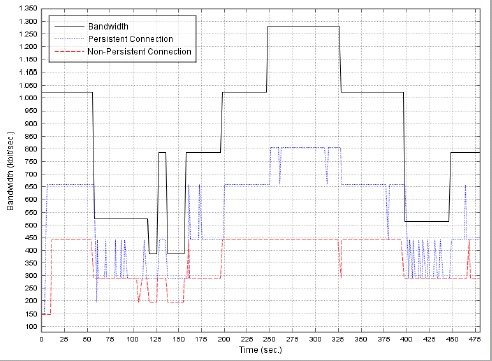
Figure 6: Non-/Persistent Connetions - 2 sec. segments.
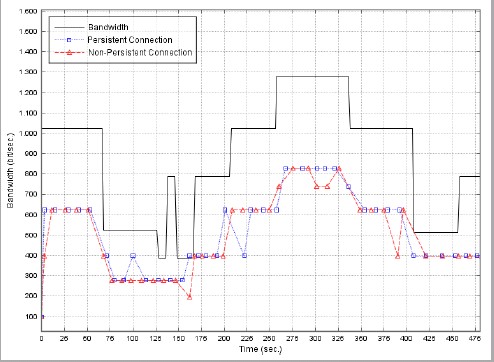
Figure 7: Non-/Persistent Connetions - 15 sec. segments.
在我们的评测中获得了很重要的一点结论:
当Web server未开长连接时,分段长度小于等于2秒时,会造成性能的显著下降。
In our evaluation the streaming using persistent connections corresponds with the findings from [25] and [26] that for TCPbased
streaming one needs about the double bandwidth of the media bitrate to achieve a sufficient performance. Streaming
without persistent connections results in a significantly higher bandwidth demand and the average media bitrate in our
evaluation of 2-seconds segment in Figure 6 is about 34% lower than using persistent connections. The average bitrate in the worst
scenario with 1-second segments drops by 46% in comparison to a Web server with persistent connections enabled as shown inFigure 8.
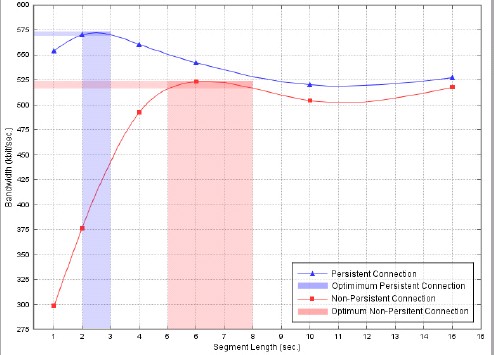
Figure 8: Segment length/Bandwidth Evaluation.
在我们的评测中,当使用长连接时,从相关的文档中得出的结论是:
基于TCP的流要获得足够的性能,要求媒体的码率是带宽的两倍。
因为短连接会消耗更多的带宽:
短连接的流会导致带宽请求的显著上升,
对于2秒的分段,使用长连接能降低34%,
对于1秒的分段,使用长连接能降低46%。如图8所示。
Segment sizes greater than 6 seconds are not influenced so much
by the connection settings of the Web server. Due to the lower
amount of segments and, thus, the smaller overhead produced by
reconnects, the difference between both configurations reduces by
2% for the 15-seconds segment length version of Big Buck Bunny
(cf. Figure 7). One can see the pretty equal media bitrate need of
both evaluations as well as the lower amount of requests shown
by squares and triangles in the plot. The requests are not shown in
Figure 6, due to the high frequency of the requests (i.e., every two
seconds) compared to one request every 15 seconds shown in Figure 7.
对于分段长度为6秒时,就基本上不受长,短连接的影响了。
Finally, we evaluated the optimal segment size of our network
configuration scenario for both cases, with and without persistent
connections. Therefore, we analyzed the performance of the 1, 2,
4, 6, 10 and 15 seconds segment length of Big Buck Bunny of our
dataset and interpolated a graph showing the performance of the
segment sizes in term average media bitrate. As shown in Figure 8
the optimal segment size for this network setting would be
between 2 and 3 seconds using persistent connections and
between 5 and 8 without using them. The bitrate of the optimal
segment lengths of both configurations differs by about 50 kbit/sec.
最后,我们评测了对2~3秒长的分段设置成长连接的结果。
6. Conclusion and Future Work【总结和未来的工作】
In this paper we provide, to the best of our knowledge, the first
DASH dataset comprising different genres, most of them in HD
quality. In comparison to other sources for video test content,
which mostly offer clips with only a few seconds of length, this
dataset is especially designed for DASH-based evaluations and
consists of videos between 10 and 90 minutes.
提供了10~90分钟的数据集。
Each video of this dataset is provided in different segment lengths
as well as in different representations ranging from 50 kbit/sec. up
to several MBit/sec. One can use this dataset to compare DASHbased
streaming clients/systems in an objective way with a
common content basis. Additionally, we provide PSNR values for
every frame of the Big Buck Bunny representations, which
provide even more evaluation possibilities for researchers.
做了分段时长 ,PSNR的对比。
We also developed a convenient content generation tool called
DASHEncoder, which we used for the encoding of this dataset.
This fully configurable and extensible DASH encoding tool is
offered as open source at [14].
开发了DASHEncoder.
Finally, we showed an evaluation of the optimal segment size for
a given network configuration based on our dataset. We also
showed the influence of enabled versus disabled persistent
connections of Web servers to the streaming performance of
DASH. Therefore, we build a simulation environment for
performing tests to get the optimal segment size for those different
scenarios.
对分段做了优化。
Based on this dataset we plan to do research on stream switching
algorithms and DASH-based systems in general. We also plan to
update and extend our dataset in the future, like adding alternative
encodings or audio tracks to the existing videos. Additionally, we
will include versions with different sub-segment lengths and other
media formats.
需要再做研究的有:
流切换,扩展数据集,添加音轨,增加媒体格式。
7. ACKNOWLEDGMENTS
This work was supported in part by the EC in the context of the
ALICANTE (FP7-ICT-248652) and SocialSensor (FP7-ICT-
287975), and QUALINET (COST IC 1003) projects. Special
thanks to the Red Bull Media House for providing us the Red Bull
Playstreets video. They own the rights of the content but the usage
for scientific purposes is permitted. Special thanks also to the
team of Valkaama and to the producer Tim Baumann for
providing us this content.
8. REFERENCES
[1] Schonfeld, E., Tech Crunch, 2011. Netflix Now The Largest
Single Source of Internet Traffic In North America (posted
on May 17th, 2011),
http://techcrunch.com/2011/05/17/netflix-largest-internettraffic/
(last access: Dec. 2011)
[2] Microsoft Smooth Streaming,
http://www.iis.net/download/smoothstreaming (last access:
Aug. 2011).
[3] Adobe HTTP Dynamic Streaming,
http://help.adobe.com/en_US/HTTPStreaming/1.0/Using/ind
ex.html, (last access: Dec. 2011)
[4] Pantos, R., May, W. 2010. HTTP Live Streaming, IETF
draft (Jun. 2010) http://tools.ietf.org/html/draft-pantos-httplive-
streaming-04 (last access: Dec. 2010).
[5] Stockhammer, T. 2011, Dynamic Adaptive Streaming over
HTTP ?– Design Principles and Standards, In Proceedings of
the second annual ACM conference on Multimedia systems
(MMSys11), ACM, New York, NY, USA
[6] Sodagar, I., The MPEG-DASH Standard for Multimedia
Streaming Over the Internet, IEEE Multimedia, vol. 18, no.
4, pp. 62-67, Oct.-Dec. 2011
[7] ISO/IEC DIS 23009-1.2, Information technology ?—
Dynamic adaptive streaming over HTTP (DASH) ?— Part 1:
Media presentation description and segment formats.
[8] Riiser, H., Halvorsen, P., Griwodz, C., Johansen, D. 2010.
Low overhead container format for adaptive streaming.
Proceedings of the First Annual ACM SIGMM Conference
on Multimedia Systems (MMSys), ACM, New York, NY,
USA
[9] Evensen, K., Kaspar, D., Griwodz, C., Halvorsen, P. 2011.
Improving the Performance of Quality-Adaptive Video
Streaming over Multiple Heterogeneous Access Networks, In
Proceedings of the second annual ACM conference on
Multimedia systems (MMSys11), ACM, New York, NY,
USA
[10] Smooth Streaming Showcase,
http://www.iis.net/media/experiencesmoothstreaming, (last
access: Dec. 2011).
[11] Flash Media Server,
http://www.adobe.com/products/flashmediaserver/, (last
access: Dec. 2011)
[12] Ericsson AHS Content at ITEC/Alpen-Adria-Universit?t
Klagenfurt, http://www-itec.uni-klu.ac.at/dash/?page_id=6
(last access: Dec 2011)
[13] Le Feuvre, J., Concolato, C., Dufourd, J.-C., Bouqueau, R.,
Moissinac, J.-C. 2011. Experimenting with Multimedia
Advances using GPAC, Proceedings of ACM Conference on
Multimedia (ACM MM) 2011, ACM, New York, NY, USA
[14] DASHEncoder at ITEC/Alpen-Adria-Universit?t Klagenfurt,
http://www-itec.uni-klu.ac.at/dash/?page_id=282 (last
access: Dec. 2011)
[15] Müller, C., Timmerer, C. 2011. A Test-Bed for the Dynamic
Adaptive Streaming over HTTP featuring Session Mobility,
In Proceedings of the second annual ACM conference on
Multimedia systems (MMSys11), ACM, New York, NY,
USA
[16] X264, http://www.videolan.org/developers/x264.html, (last
access: Dec. 2011)
[17] Big Buck Bunny Movie, http://www.bigbuckbunny.org (last
access: Dec. 2011)
[18] Elephants Dream Movie, http://www.elephantsdream.org,
(last access: Dec. 2011)
[19] The Swiss Account, http://lt11.com/2011/07/18/the-swissaccount-
2 (last access: Dec. 2011)
[20] Valkaama Movie, http://www.valkaama.com, (last access:
Dec. 2011)
[21] Of Forest and Men, http://www.offorestsandmen.org, (last
access: Dec. 2011)
[22] DASH Dataset at ITEC/Alpen-Adria-Universit?t Klagenfurt,
http://www-itec.uni-klu.ac.at/dash/?page_id=207 (last
access: Dec. 2011)
[23] Fielding, R. et al, RFC 2068 - Hypertext Transfer Protocol --
HTTP/1.1,
http://www.w3.org/Protocols/rfc2616/rfc2616.html (last
access: Dec. 2011).
[24] Apache HTTP Server Project, http://httpd.apache.org/ (last
access: Dec. 2011).
[25] Kuschnig, R., Kofler, I., Hellwagner, H. 2010. An
Evaluation of TCP-based Rate-control Algorithms for
Adaptive Internet Streaming of H.264/SVC, Proceedings of
the First Annual ACM SIGMM Conference on Multimedia
Systems (MMSys), ACM, New York, NY, USA
[26] Wang,B., Kurose, J., Shenoy, P., and Towsley,D. 2008.
Multimedia streaming via TCP: An analytic performance
study.ACMTrans.Multimedia Comput. Commun. Appl. 4, 2,
Article 16 (May 2008)
94





 本文介绍了一种用于动态自适应HTTP流媒体(DASH)技术的测试数据集,包括不同类型的视频内容及其多种分辨率和比特率的版本。此外,还提供了一个名为DASHEncoder的开源工具,用于生成符合DASH标准的视频内容。
本文介绍了一种用于动态自适应HTTP流媒体(DASH)技术的测试数据集,包括不同类型的视频内容及其多种分辨率和比特率的版本。此外,还提供了一个名为DASHEncoder的开源工具,用于生成符合DASH标准的视频内容。
















 3万+
3万+

 被折叠的 条评论
为什么被折叠?
被折叠的 条评论
为什么被折叠?








